torque JEEP WRANGLER UNLIMITED 2021 Owner handbook (in English)
[x] Cancel search | Manufacturer: JEEP, Model Year: 2021, Model line: WRANGLER UNLIMITED, Model: JEEP WRANGLER UNLIMITED 2021Pages: 330, PDF Size: 9.16 MB
Page 155 of 330
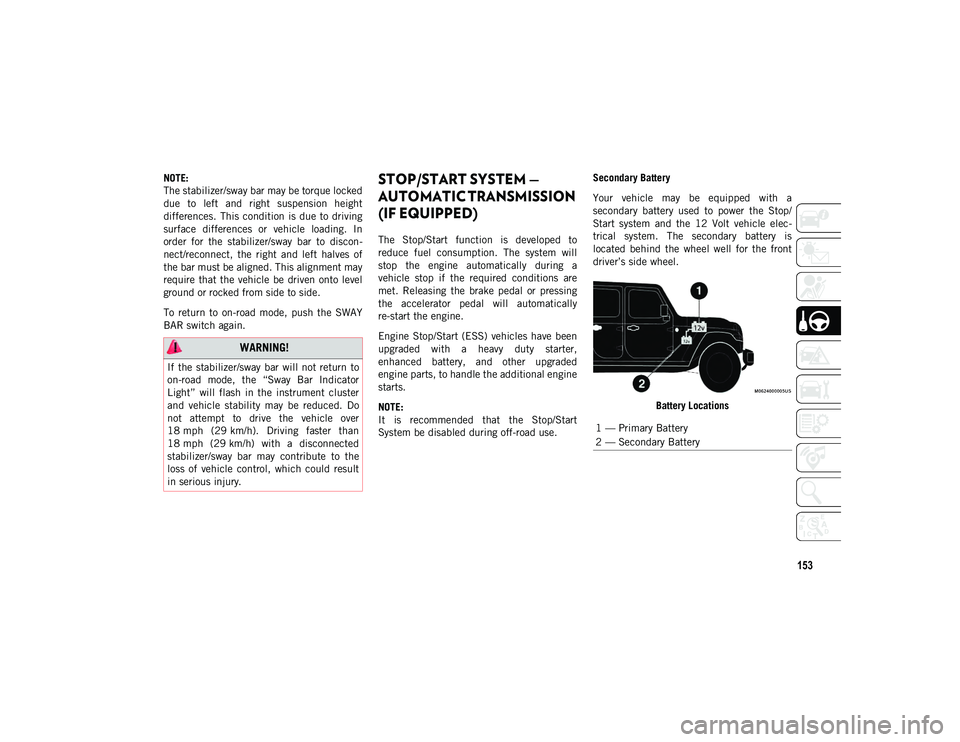
153
NOTE:
The stabilizer/sway bar may be torque locked
due to left and right suspension height
differences. This condition is due to driving
surface differences or vehicle loading. In
order for the stabilizer/sway bar to discon-
nect/reconnect, the right and left halves of
the bar must be aligned. This alignment may
require that the vehicle be driven onto level
ground or rocked from side to side.
To return to on-road mode, push the SWAY
BAR switch again.
STOP/START SYSTEM —
AUTOMATIC TRANSMISSION
(IF EQUIPPED)
The Stop/Start function is developed to
reduce fuel consumption. The system will
stop the engine automatically during a
vehicle stop if the required conditions are
met. Releasing the brake pedal or pressing
the accelerator pedal will automatically
re-start the engine.
Engine Stop/Start (ESS) vehicles have been
upgraded with a heavy duty starter,
enhanced battery, and other upgraded
engine parts, to handle the additional engine
starts.
NOTE:
It is recommended that the Stop/Start
System be disabled during off-road use. Secondary Battery
Your vehicle may be equipped with a
secondary battery used to power the Stop/
Start system and the 12 Volt vehicle elec
-
trical system. The secondary battery is
located behind the wheel well for the front
driver’s side wheel.
Battery Locations
WARNING!
If the stabilizer/sway bar will not return to
on-road mode, the “Sway Bar Indicator
Light” will flash in the instrument cluster
and vehicle stability may be reduced. Do
not attempt to drive the vehicle over
18 mph (29 km/h). Driving faster than
18 mph (29 km/h) with a disconnected
stabilizer/sway bar may contribute to the
loss of vehicle control, which could result
in serious injury.
1 — Primary Battery
2 — Secondary Battery
2020_JEEP_JL_WRANGLER_UG_RHD_UK.book Page 153
Page 173 of 330
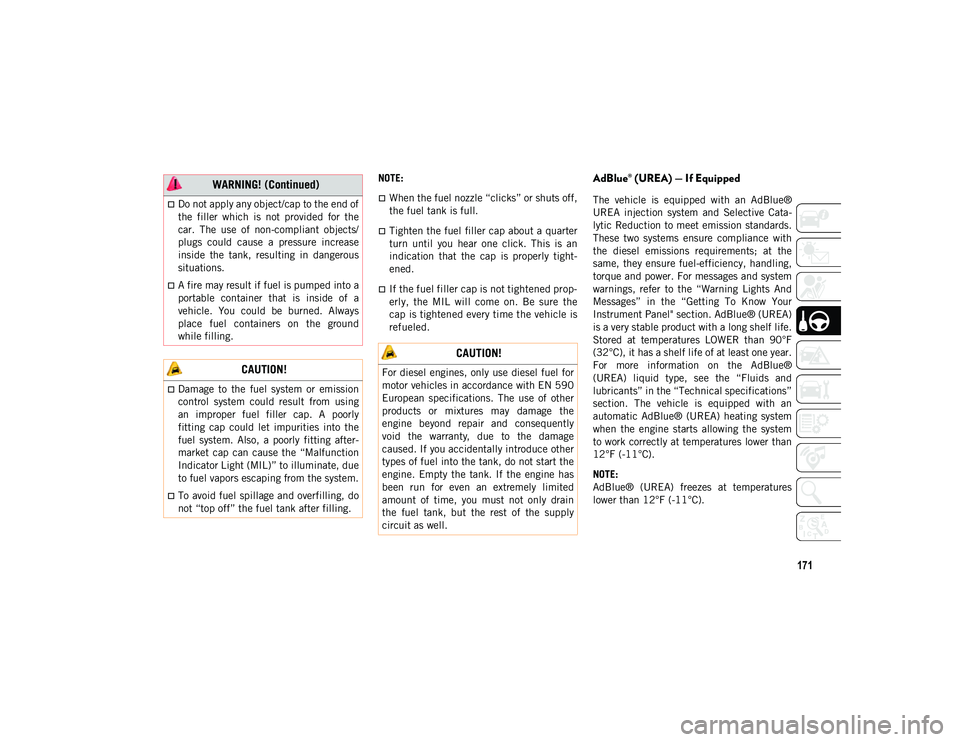
171
NOTE:
When the fuel nozzle “clicks” or shuts off,
the fuel tank is full.
Tighten the fuel filler cap about a quarter
turn until you hear one click. This is an
indication that the cap is properly tight-
ened.
If the fuel filler cap is not tightened prop -
erly, the MIL will come on. Be sure the
cap is tightened every time the vehicle is
refueled.
AdBlue® (UREA) — If Equipped
The vehicle is equipped with an AdBlue®
UREA injection system and Selective Cata -
lytic Reduction to meet emission standards.
These two systems ensure compliance with
the diesel emissions requirements; at the
same, they ensure fuel-efficiency, handling,
torque and power. For messages and system
warnings, refer to the “Warning Lights And
Messages” in the “Getting To Know Your
Instrument Panel" section. AdBlue® (UREA)
is a very stable product with a long shelf life.
Stored at temperatures LOWER than 90°F
(32°C), it has a shelf life of at least one year.
For more information on the AdBlue®
(UREA) liquid type, see the “Fluids and
lubricants” in the “Technical specifications”
section. The vehicle is equipped with an
automatic AdBlue® (UREA) heating system
when the engine starts allowing the system
to work correctly at temperatures lower than
12°F (-11°C).
NOTE:
AdBlue® (UREA) freezes at temperatures
lower than 12°F (-11°C).Do not apply any object/cap to the end of
the filler which is not provided for the
car. The use of non-compliant objects/
plugs could cause a pressure increase
inside the tank, resulting in dangerous
situations.
A fire may result if fuel is pumped into a
portable container that is inside of a
vehicle. You could be burned. Always
place fuel containers on the ground
while filling.
CAUTION!
Damage to the fuel system or emission
control system could result from using
an improper fuel filler cap. A poorly
fitting cap could let impurities into the
fuel system. Also, a poorly fitting after -
market cap can cause the “Malfunction
Indicator Light (MIL)” to illuminate, due
to fuel vapors escaping from the system.
To avoid fuel spillage and overfilling, do
not “top off” the fuel tank after filling.
WARNING! (Continued)
CAUTION!
For diesel engines, only use diesel fuel for
motor vehicles in accordance with EN 590
European specifications. The use of other
products or mixtures may damage the
engine beyond repair and consequently
void the warranty, due to the damage
caused. If you accidentally introduce other
types of fuel into the tank, do not start the
engine. Empty the tank. If the engine has
been run for even an extremely limited
amount of time, you must not only drain
the fuel tank, but the rest of the supply
circuit as well.
2020_JEEP_JL_WRANGLER_UG_RHD_UK.book Page 171
Page 199 of 330
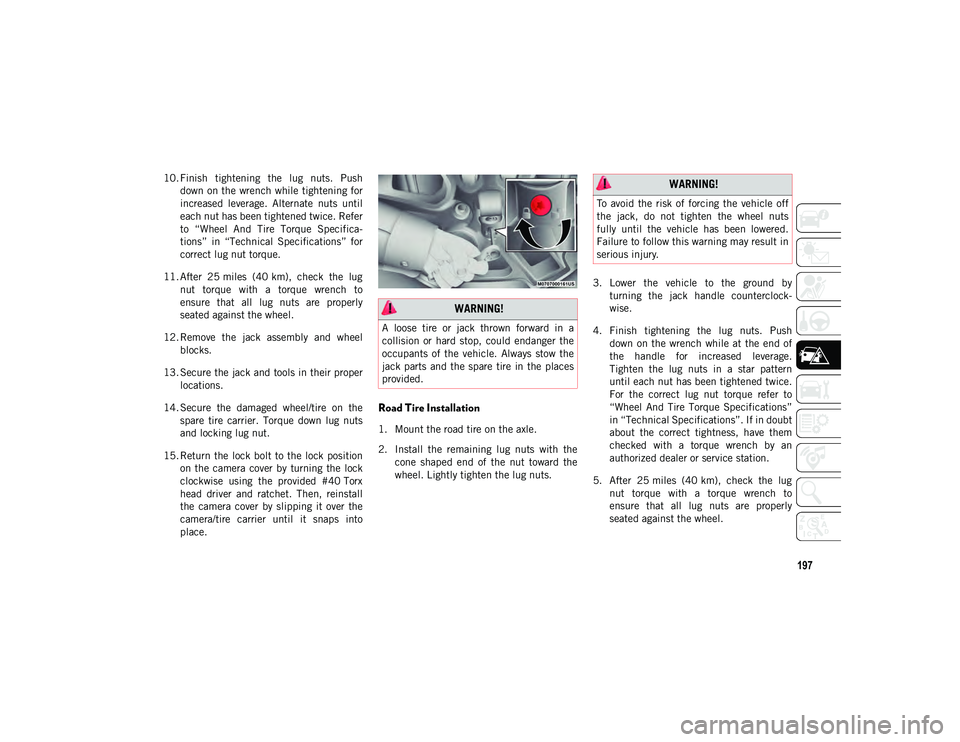
197
10. Finish tightening the lug nuts. Pushdown on the wrench while tightening for
increased leverage. Alternate nuts until
each nut has been tightened twice. Refer
to “Wheel And Tire Torque Specifica -
tions” in “Technical Specifications” for
correct lug nut torque.
11. After 25 miles (40 km), check the lug nut torque with a torque wrench to
ensure that all lug nuts are properly
seated against the wheel.
12. Remove the jack assembly and wheel blocks.
13. Secure the jack and tools in their proper locations.
14. Secure the damaged wheel/tire on the spare tire carrier. Torque down lug nuts
and locking lug nut.
15. Return the lock bolt to the lock position on the camera cover by turning the lock
clockwise using the provided #40 Torx
head driver and ratchet. Then, reinstall
the camera cover by slipping it over the
camera/tire carrier until it snaps into
place.
Road Tire Installation
1. Mount the road tire on the axle.
2. Install the remaining lug nuts with thecone shaped end of the nut toward the
wheel. Lightly tighten the lug nuts. 3. Lower the vehicle to the ground by
turning the jack handle counterclock -
wise.
4. Finish tightening the lug nuts. Push down on the wrench while at the end of
the handle for increased leverage.
Tighten the lug nuts in a star pattern
until each nut has been tightened twice.
For the correct lug nut torque refer to
“Wheel And Tire Torque Specifications”
in “Technical Specifications”. If in doubt
about the correct tightness, have them
checked with a torque wrench by an
authorized dealer or service station.
5. After 25 miles (40 km), check the lug nut torque with a torque wrench to
ensure that all lug nuts are properly
seated against the wheel.
WARNING!
A loose tire or jack thrown forward in a
collision or hard stop, could endanger the
occupants of the vehicle. Always stow the
jack parts and the spare tire in the places
provided.
WARNING!
To avoid the risk of forcing the vehicle off
the jack, do not tighten the wheel nuts
fully until the vehicle has been lowered.
Failure to follow this warning may result in
serious injury.
2020_JEEP_JL_WRANGLER_UG_RHD_UK.book Page 197
Page 233 of 330
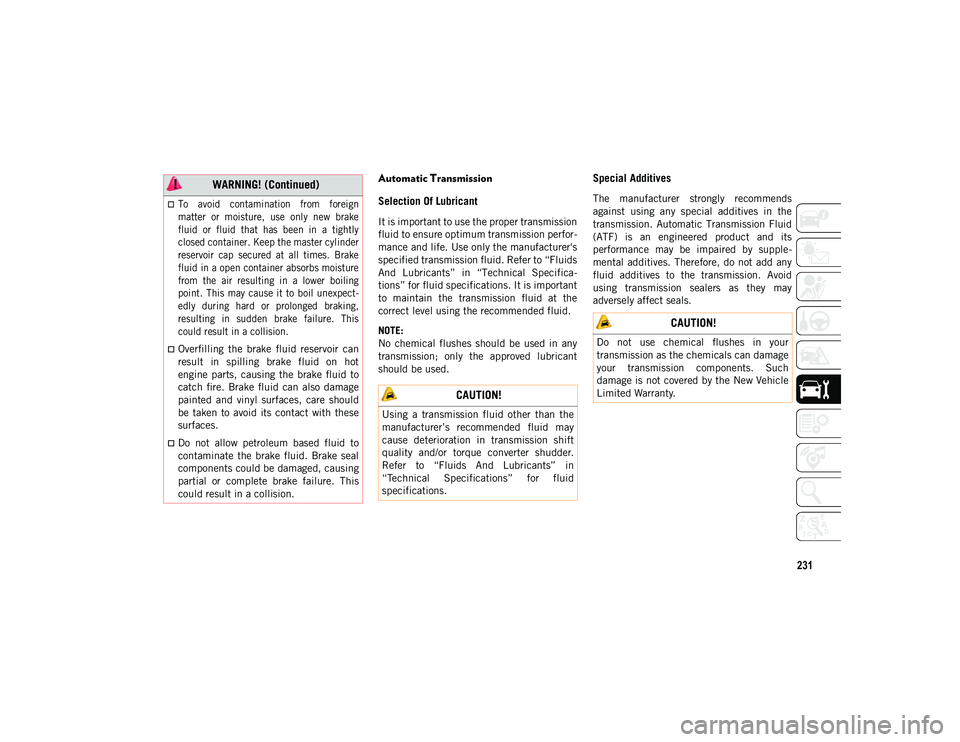
231
Automatic Transmission
Selection Of Lubricant
It is important to use the proper transmission
fluid to ensure optimum transmission perfor-
mance and life. Use only the manufacturer's
specified transmission fluid. Refer to “Fluids
And Lubricants” in “Technical Specifica -
tions” for fluid specifications. It is important
to maintain the transmission fluid at the
correct level using the recommended fluid.
NOTE:
No chemical flushes should be used in any
transmission; only the approved lubricant
should be used.
Special Additives
The manufacturer strongly recommends
against using any special additives in the
transmission. Automatic Transmission Fluid
(ATF) is an engineered product and its
performance may be impaired by supple -
mental additives. Therefore, do not add any
fluid additives to the transmission. Avoid
using transmission sealers as they may
adversely affect seals.
To avoid contamination from foreign
matter or moisture, use only new brake
fluid or fluid that has been in a tightly
closed container. Keep the master cylinder
reservoir cap secured at all times. Brake
fluid in a open container absorbs moisture
from the air resulting in a lower boiling
point. This may cause it to boil unexpect -
edly during hard or prolonged braking,
resulting in sudden brake failure. This
could result in a collision.
Overfilling the brake fluid reservoir can
result in spilling brake fluid on hot
engine parts, causing the brake fluid to
catch fire. Brake fluid can also damage
painted and vinyl surfaces, care should
be taken to avoid its contact with these
surfaces.
Do not allow petroleum based fluid to
contaminate the brake fluid. Brake seal
components could be damaged, causing
partial or complete brake failure. This
could result in a collision.
WARNING! (Continued)
CAUTION!
Using a transmission fluid other than the
manufacturer’s recommended fluid may
cause deterioration in transmission shift
quality and/or torque converter shudder.
Refer to “Fluids And Lubricants” in
“Technical Specifications” for fluid
specifications.
CAUTION!
Do not use chemical flushes in your
transmission as the chemicals can damage
your transmission components. Such
damage is not covered by the New Vehicle
Limited Warranty.
2020_JEEP_JL_WRANGLER_UG_RHD_UK.book Page 231
Page 249 of 330
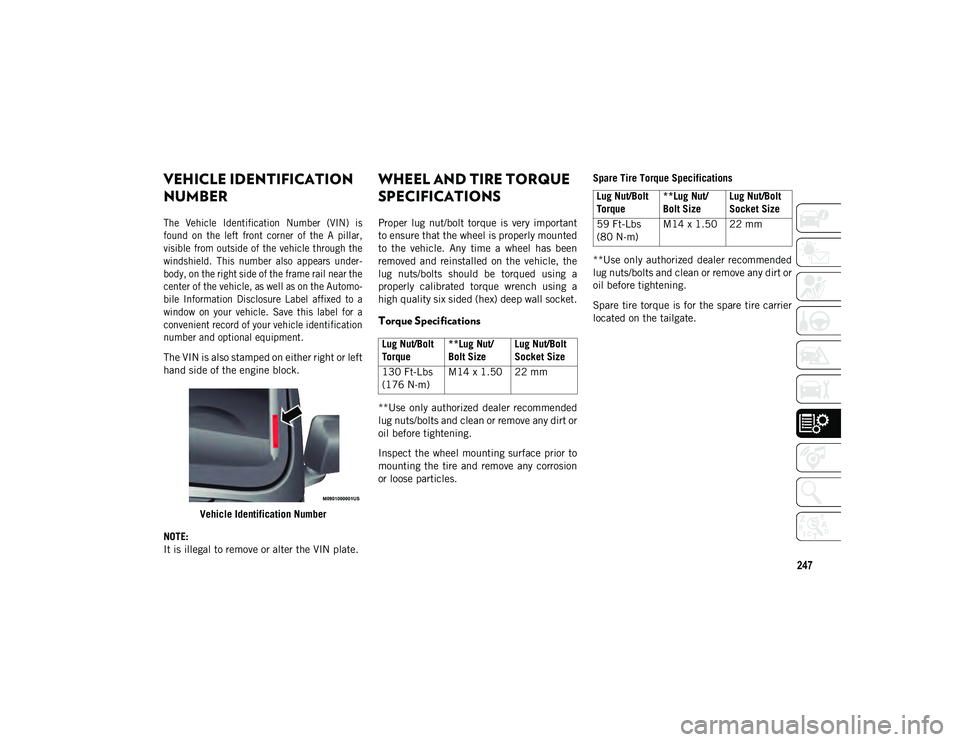
247
TECHNICAL SPECIFICATIONS
VEHICLE IDENTIFICATION
NUMBER
The Vehicle Identification Number (VIN) is
found on the left front corner of the A pillar,
visible from outside of the vehicle through the
windshield. This number also appears under-
body, on the right side of the frame rail near the
center of the vehicle, as well as on the Automo-
bile Information Disclosure Label affixed to a
window on your vehicle. Save this label for a
convenient record of your vehicle identification
number and optional equipment.
The VIN is also stamped on either right or left
hand side of the engine block.
Vehicle Identification Number
NOTE:
It is illegal to remove or alter the VIN plate.
WHEEL AND TIRE TORQUE
SPECIFICATIONS
Proper lug nut/bolt torque is very important
to ensure that the wheel is properly mounted
to the vehicle. Any time a wheel has been
removed and reinstalled on the vehicle, the
lug nuts/bolts should be torqued using a
properly calibrated torque wrench using a
high quality six sided (hex) deep wall socket.
Torque Specifications
**Use only authorized dealer recommended
lug nuts/bolts and clean or remove any dirt or
oil before tightening.
Inspect the wheel mounting surface prior to
mounting the tire and remove any corrosion
or loose particles. Spare Tire Torque Specifications
**Use only authorized dealer recommended
lug nuts/bolts and clean or remove any dirt or
oil before tightening.
Spare tire torque is for the spare tire carrier
located on the tailgate.
Lug Nut/Bolt
Torque
**Lug Nut/
Bolt SizeLug Nut/Bolt
Socket Size
130 Ft-Lbs
(176 N·m) M14 x 1.50 22 mm
Lug Nut/Bolt
Torque**Lug Nut/
Bolt SizeLug Nut/Bolt
Socket Size
59 Ft-Lbs
(80 N·m) M14 x 1.50 22 mm
2020_JEEP_JL_WRANGLER_UG_RHD_UK.book Page 247
Page 250 of 330
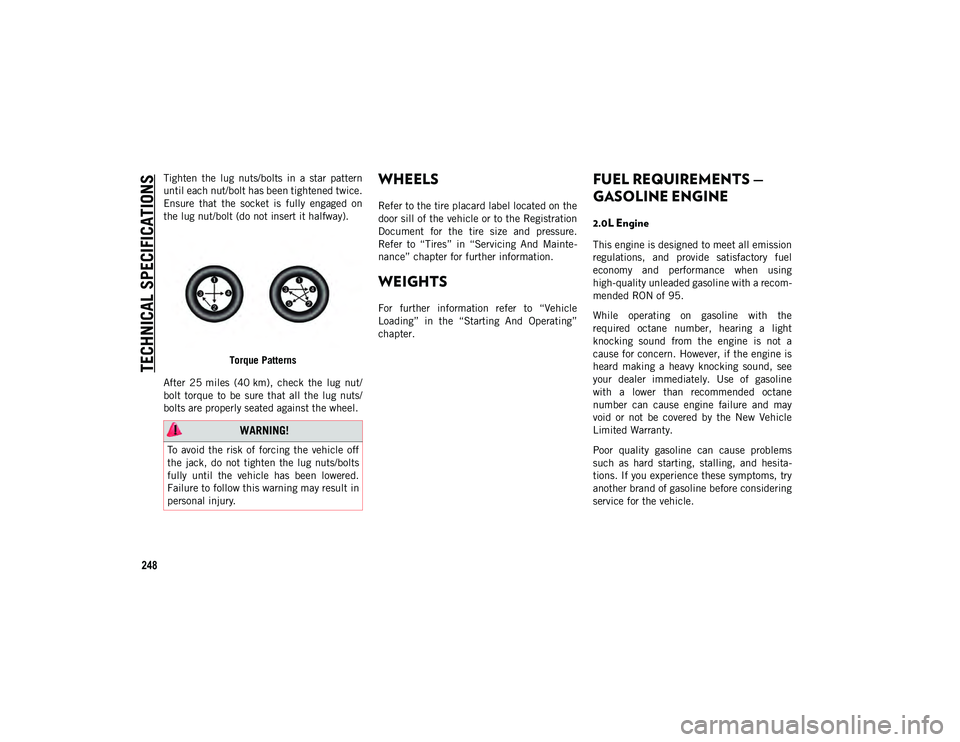
TECHNICAL SPECIFICATIONS
248
Tighten the lug nuts/bolts in a star pattern
until each nut/bolt has been tightened twice.
Ensure that the socket is fully engaged on
the lug nut/bolt (do not insert it halfway).Torque Patterns
After 25 miles (40 km), check the lug nut/
bolt torque to be sure that all the lug nuts/
bolts are properly seated against the wheel.WHEELS
Refer to the tire placard label located on the
door sill of the vehicle or to the Registration
Document for the tire size and pressure.
Refer to “Tires” in “Servicing And Mainte -
nance” chapter for further information.
WEIGHTS
For further information refer to “Vehicle
Loading” in the “Starting And Operating”
chapter.
FUEL REQUIREMENTS —
GASOLINE ENGINE
2.0L Engine
This engine is designed to meet all emission
regulations, and provide satisfactory fuel
economy and performance when using
high-quality unleaded gasoline with a recom -
mended RON of 95.
While operating on gasoline with the
required octane number, hearing a light
knocking sound from the engine is not a
cause for concern. However, if the engine is
heard making a heavy knocking sound, see
your dealer immediately. Use of gasoline
with a lower than recommended octane
number can cause engine failure and may
void or not be covered by the New Vehicle
Limited Warranty.
Poor quality gasoline can cause problems
such as hard starting, stalling, and hesita -
tions. If you experience these symptoms, try
another brand of gasoline before considering
service for the vehicle.
WARNING!
To avoid the risk of forcing the vehicle off
the jack, do not tighten the lug nuts/bolts
fully until the vehicle has been lowered.
Failure to follow this warning may result in
personal injury.
2020_JEEP_JL_WRANGLER_UG_RHD_UK.book Page 248
Page 327 of 330
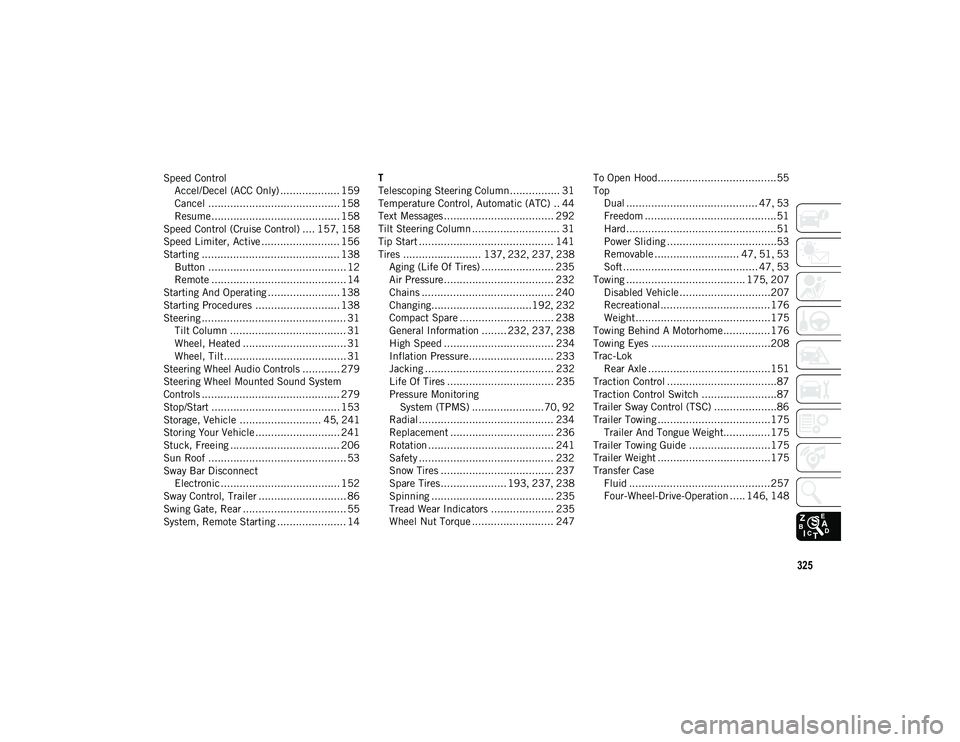
325
Speed ControlAccel/Decel (ACC Only) ................... 159
Cancel .......................................... 158
Resume......................................... 158
Speed Control (Cruise Control) .... 157 , 158
Speed Limiter, Active ......................... 156
Starting ............................................ 138 Button ............................................ 12
Remote ........................................... 14
Starting And Operating ....................... 138
Starting Procedures ........................... 138
Steering .............................................. 31 Tilt Column ..................................... 31
Wheel, Heated ................................. 31
Wheel, Tilt....................................... 31
Steering Wheel Audio Controls ............ 279
Steering Wheel Mounted Sound System
Controls ............................................ 279
Stop/Start ......................................... 153
Storage, Vehicle .......................... 45 , 241
Storing Your Vehicle........................... 241
Stuck, Freeing ................................... 206
Sun Roof ............................................ 53
Sway Bar Disconnect Electronic ...................................... 152
Sway Control, Trailer ............................ 86
Swing Gate, Rear ................................. 55
System, Remote Starting ...................... 14 T
Telescoping Steering Column................ 31
Temperature Control, Automatic (ATC) .. 44
Text Messages ................................... 292
Tilt Steering Column ............................ 31
Tip Start ........................................... 141
Tires ......................... 137
, 232 , 237 , 238
Aging (Life Of Tires) ....................... 235
Air Pressure................................... 232
Chains .......................................... 240
Changing................................192 , 232
Compact Spare .............................. 238
General Information ........ 232 , 237 , 238
High Speed ................................... 234
Inflation Pressure........................... 233
Jacking ......................................... 232
Life Of Tires .................................. 235
Pressure Monitoring System (TPMS) .......................70 , 92
Radial........................................... 234
Replacement ................................. 236
Rotation ........................................ 241
Safety ........................................... 232
Snow Tires .................................... 237
Spare Tires..................... 193 , 237 , 238
Spinning ....................................... 235
Tread Wear Indicators .................... 235 Wheel Nut Torque .......................... 247 To Open Hood......................................55
Top
Dual .......................................... 47 , 53
Freedom ..........................................51
Hard................................................51
Power Sliding ...................................53
Removable ........................... 47 , 51 , 53
Soft ........................................... 47 , 53
Towing ...................................... 175 , 207
Disabled Vehicle .............................207
Recreational...................................176
Weight...........................................175
Towing Behind A Motorhome ...............176
Towing Eyes ......................................208
Trac-Lok Rear Axle .......................................151
Traction Control ...................................87
Traction Control Switch ........................87
Trailer Sway Control (TSC) ....................86
Trailer Towing ....................................175 Trailer And Tongue Weight...............175
Trailer Towing Guide ..........................175
Trailer Weight ....................................175
Transfer Case Fluid .............................................257Four-Wheel-Drive-Operation ..... 146 , 148
2020_JEEP_JL_WRANGLER_UG_RHD_UK.book Page 325